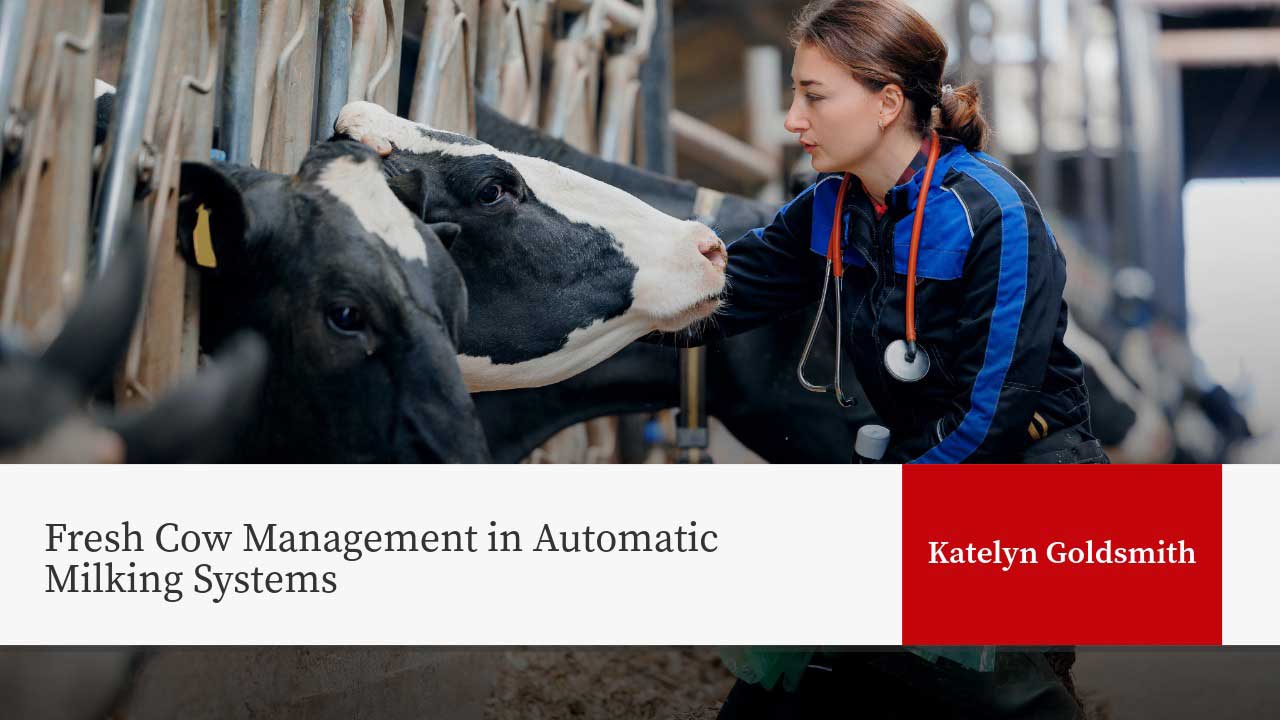
Introduction
Fresh cows are a critical group on the farm. Cows’ success during the fresh period lays the foundation for their lactation. While many core strategies for fresh cow management apply across both conventional and Automatic Milking Systems (AMS) 🔍, AMS facilities introduce some unique considerations. Understanding these can help farmers optimize cow health, production, and farm workflow.
Colostrum Collection
There are different routes that people take when it comes to colostrum collection in AMS situations. These include milking in a conventional milking system, bucket milking, or in the robot – all of which are effective. Farms should choose their method based on how it fits into their workflow and preference.
Automatic Milking System
Using the AMS for colostrum collection is a common practice among farms that have fully transitioned away from conventional systems. The process of visiting the robot should be as low stress as possible to encourage good milk let down. Milk that is collected by the AMS for feeding or storage should be quickly retrieved to preserve its quality and hygiene.
Conventional Milking System
Some farms may choose to milk fresh cows in a conventional system, such as a parlor. This may be because the farm has chosen to keep their previous systems in place for milking select cows such as fresh or treated cows. Other farms may choose to milk a portion of the herd in robots and the remaining cows in a conventional system. Regardless of the situation, milking fresh cows in these systems can allow farmers to easily monitor these animals and collect colostrum.
Portable Bucket Milking
Some farms may choose not to use a conventional system, but may still want to use a method other than the AMS for collecting colostrum. In this case, some farms may choose to use a mobile milking set-up to bucket milk cows for colostrum. This can allow farms to collect colostrum quickly after calving without introducing the cow immediately to the AMS. This may also be helpful if farms are unable to quickly move cows to the AMS after calving due to unique farm constraints.
A Note on Managing Cows with Milk Residue Risks
Cows treated with antibiotic therapy at dry-off require a milk withdrawal period. Label directions for meat and milk withholding should always be followed strictly. It is essential for farms using AMS to have a clear strategy for managing these cows to reduce the risk of antibiotic residues in milk and optimize system efficiency.
AMS units can safely and effectively milk treated cows and discard their milk, but doing so typically requires additional wash cycles after these milkings. These extra washes can reduce the availability and overall efficiency of the AMS. Farms must also ensure that milking settings are correctly programmed so the system identifies treated cows and discards their milk accordingly.
Given these considerations, some farms may choose to continue using a conventional milking system or a portable bucket milker for treated cows. Others may designate an AMS pen for treated cows. While there are often not enough treated cows to fill an entire pen, these pens may also serve as a fresh cow pen or house cows that visit the robot less frequently (i.e., late lactation cows). This approach helps minimize disruptions to the AMS availability and milking efficiency.
Creating a Fresh Cow Group
Establishing a dedicated fresh cow group or pen can be a highly effective management strategy when facilities and resources allow it. A fresh cow group allows for close monitoring during the postpartum period, reduces social competition from dominant cows, and enables feeding of a specific fresh cow diet.
Fresh cow groups can vary in size and location. Some farms may allocate an entire pen, while others may use smaller adjacent pens (e.g. special needs pens 🔍) that share access to the AMS units. Regardless of setup, farms must determine:
- How long cows will remain in the fresh group.
- When and how cows will be moved between pens.
- Where cows will go after leaving the fresh pen.
Any seasonal calving patterns should be considered to avoid overcrowding during peak periods. Facility design should support low-stress cow movement, making transitions between groups smooth and efficient for both animals and staff.
For more insights into grouping strategies, read our related article: Grouping Strategies in AMS. [coming soon]
Training Fresh Cows to Use the AMS
Training is a critical step to set fresh cows up for success, especially first-lactation cows who are unfamiliar with the AMS. Proper training can help cows establish a consistent milking routine, encourage voluntary visits to the robot, and increase milk production.
For a more detailed explanation of training protocols and strategies, see our article entitled “Encouraging Voluntary Visits in AMS”.
Transition Cow Health
Monitoring the health of transition cows remains a critical management practice, regardless of milking system. A smooth and healthy transition supports optimal milk production, reproductive performance, and overall cow success. This makes early detection and intervention of health issues important.
To date, comparisons of fresh cow health between conventional and AMS herds are limited. But some research exists that suggests herds using AMS may experience higher rates of ketosis than those using conventional milking systems (1). Ketosis is the excessive buildup of ketones in the blood caused by the body mobilizing fat. This can occur during times of negative energy balance, such as the fresh period, when the body may mobilize fat to provide energy to meet demands. Increased rates of ketosis in AMS herds may be related to several factors including milking frequency, milk production, and concentrate 🔍 allowance.
Subclinical ketosis (SCK), which affects more cows than clinical ketosis, was the focus of a research study by King and colleagues (2,3). Cows with SCK are at an increased risk of postpartum disease such as displaced abomasum and metritis (3). Notably, cows diagnosed with both SCK and another health issue in AMS herds showed reduced milk production and milking frequency (2).
High milk production has been associated with SCK risk (2,4). AMS allows for individualized milking which can lead to more frequent milking of fresh cows compared to conventional systems (5). Increased milking frequency has been shown to increase milk production which may therefore increase a cow’s risk for SCK (6).
Concentrate allowance may be another contributing factor. In King’s study, cows with SCK had higher milk yield to concentrate intake ratios, meaning they consumed less concentrate relative to their milk production than cows without SCK (2). This suggests that SCK cows may not be receiving sufficient energy from the AMS feed to further support their greater milk production and energy demands
Preventing ketosis typically involves increasing energy intake while maintaining a healthy rumen. In AMS herds, one approach is to raise the concentrate allowance for fresh cows. However, this must be done carefully and with an effort to maintain or increas partial mixed ration (PMR) 🔍 intake. Increasing AMS feed intake can cause a substitution effect where cows reduce their PMR intake. Research shows that for every additional pound of AMS concentrate consumed, PMR intake drops between 0.5 to 1.5 pounds (7). This reduction can be detrimental if it lowers overall energy intake or deprives the cow of beneficial fiber and nutrients from the PMR. To address this, farms may also consider feeding a liquid supplement such as molasses to increase energy consumption without increasing AMS feed allocation. This has been shown to reduce repeat cases of SCK in fresh cows (8).
To learn more about ketosis identification, treatment, and prevention, read our guide.
Adjusting feed table 🔍 settings may help reduce the risk of SCK. However, farms should focus overall on encouraging greater intake of well formulated rations that meet the cow’s nutritional needs and support rumen health.
Beyond ketosis, other health concerns such as mastitis, metritis, and displaced abomasum are also important to monitor for. The key principles of transition cow management still apply. Daily, managers should visually observe fresh cows and monitor data provided by the AMS and other technologies to identify and address issues early.
Final Thoughts
Fine tuning fresh cow management in AMS can reduce stress for both cows and farmers. By adapting strategies to fit their AMS herd – whether through grouping, feeding, or training – farmers can support a smooth transition for fresh cows and set them up for success.
Author

Katelyn Goldsmith
Dairy Outreach Specialist– In her role as a statewide Dairy Outreach Specialist, Katelyn connects research with practical farm management practices to create educational programming addressing the needs of Wisconsin dairy producers.
References
- Tatone, E.H., Duffield, T.F., LeBlanc, S.J., DeVries, T.J., & Gordon, J.L. 2017. Investigating the within-herd prevalence and risk factors for ketosis in dairy cattle in Ontario as diagnosed by the test-day concentration of β-hydroxybutyrate in milk. Journal of Dairy Science, 100:1308-1318. https://doi.org/10.3168/jds.2016-11453
- King, M.T.M, Sparkman, K.J., LeBlanc, S.J., & DeVries, T.J. 2018. Milk yield relative to supplement intake and rumination time differs by health status for fresh cows milked with automated systems. Journal of Dairy Science, 101:10168-10176. https://doi.org/10.3168/jds.2018-14671
- McArt, J.A.A., Nydam, D.V., & Oetzel, G.R. 2012. Epidemiology of subclinical ketosis in early lactation dairy cattle. Journal of Dairy Science, 95:5056-5066. https://doi.org/10.3168/jds.2012-5443
- Vanholder, T., Papen, J., Bemers, R., Vertenten, G., & Berge, A.C.B. 2014. Risk factors for subclinical and clinical ketosis and association with production parameters in dairy cows in the Netherlands. Journal of Dairy Science, 98:880-888. https://doi.org/10.3168/jds.2014-8362
- Wagnor-Storch, A.M., & Palmer, R.W. 2003. Feeding behavior, milking behavior, and milk yields of cows milked in a parlor versus an automatic milking system. Journal of Dairy Science, 88:1494-1502. https://doi.org/10.3168/jds.S0022-0302(03)73735-7
- Soberon, F., Ryan, C.M., Nydam, D.V., Galton, D.M., & Overton, T.R. 2011. The effects of increased milking frequency during early lactation on milk yield and milk composition on commercial dairy farms. Journal of Dairy Science, 94:4398-4405. https://doi.org/10.3168/jds.2010-3640
- DeVries, T.J., & Penner, G.B. n.d. Nutritional opportunities and challenges with robot milked cows. Accessed online at https://ecommons.cornell.edu/server/api/core/bitstreams/c016ef96-1d4c-4aa6-a705-71065fe0d73f/content
- Moore, S.M., King, M.T.M, Carpenter, A.J., DeVries, T.J. 2020. Behavior, health, and productivity of early-lactation dairy cows supplemented with molasses in automated milking systems. Journal of Dairy Science, 103:10506-10518. https://doi.org/10.3168/jds.2020-18649


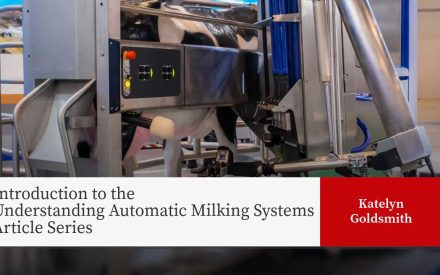 Introduction to the Understanding Automatic Milking Systems Article Series
Introduction to the Understanding Automatic Milking Systems Article Series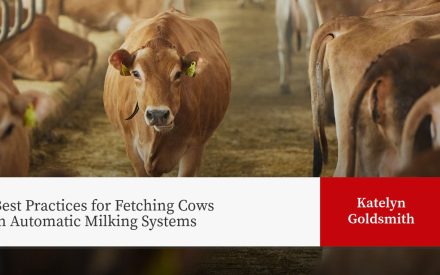 Best Practices for Fetching Cows in Automatic Milking Systems
Best Practices for Fetching Cows in Automatic Milking Systems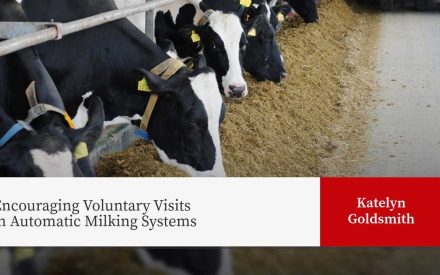 Encouraging Voluntary Visits in Automatic Milking Systems
Encouraging Voluntary Visits in Automatic Milking Systems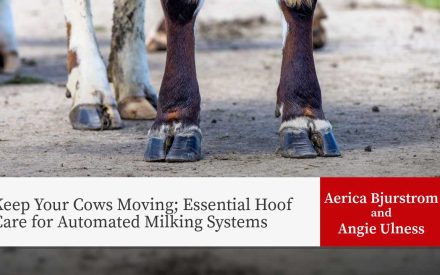 Keep Your Cows Moving; Essential Hoof Care for Automated Milking Systems
Keep Your Cows Moving; Essential Hoof Care for Automated Milking Systems


